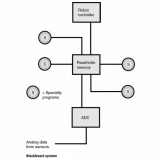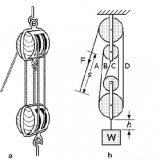Brushless DC Electric Motors 51054
What is a brushless Electric Motor ?
Short Answer: With the advent of cheap computers and power transistors, it became possible to “turn the motor inside out” and eliminate the brushes. In a brushless DC motor (BLDC), you put the permanent magnets on the rotor and you move the electromagnets to the stator. Then you use a computer (connected to high-power transistors) to charge up the electromagnets as the shaft turns.
Brushless DC electric motor (BLDC motors, BL motors) also known as electronically commutated motors (ECMs, EC motors) are synchronous motors that are powered by a DC electric source via an integrated inverter/switching power supply, which produces an AC electric signal to drive the motor.
In this context, AC, alternating current, does not imply a sinusoidal waveform, but rather a bi-directional current with no restriction on waveform. Additional sensors and electronics control the inverter output amplitude and waveform (and therefore percent of DC bus usage/efficiency) and frequency (i.e. rotor speed).
Brushless vs. Brushed Motors:
Brushed DC motors have been in commercial use since 1886. Brushless motors, on the other hand, did not become commercially viable until 1962.
Brushed DC motors develop a maximum torque when stationary, linearly decreasing as velocity increases. Some limitations of brushed motors can be overcome by brushless motors; they include higher efficiency and a lower susceptibility of the commutator assembly to mechanical wear. These benefits come at the cost of
-potentially less rugged,
-more complex,
-and more expensive control electronics.
A typical brushless motor has permanent magnets which rotate and a fixed armature, eliminating problems associated with connecting current to the moving armature. An electronic controller replaces the brush/commutator assembly of the brushed DC motor, which continually switches the phase to the windings to keep the motor turning. The controller performs similar timed power distribution by using a solid-state circuit rather than the brush/commutator system.
Brushless motors offer several advantages over brushed DC motors,
-including more torque per weight,
-more torque per watt (increased efficiency),
-increased reliability,
-reduced noise,
-longer lifetime (no brush and commutator erosion),
-elimination of ionizing sparks from the commutator,
-and overall reduction of electromagnetic interference (EMI).
With no windings on the rotor, they are not subjected to centrifugal forces, and because the windings are supported by the housing, they can be cooled by conduction, requiring no airflow inside the motor for cooling. This in turn means that the motor’s internals can be entirely enclosed and protected from dirt or other foreign matter.
Commutation with electronics instead of brushes allows for greater flexibility and capabilities not available with brushed DC motors, including speed limiting, “micro stepped” operation for slow and/or fine motion control, and a holding torque when stationary.
Brushless motors are more efficient at converting electricity into mechanical power than brushed motors. This improvement is largely due to the brushless motor’s velocity being determined by the frequency at which the electricity is switched, not the voltage.
Motion Control Systems;
Brushless motors are commonly used as pump, fan and spindle drives in adjustable or variable speed applications. They can develop high torque with good speed response. In addition, they can be easily automated for remote control. Due to their construction, they have good thermal characteristics and high energy efficiency. To obtain a variable speed response, brushless motors operate in an electromechanical system that includes an electronic motor controller and a rotor position feedback sensor.
Brushless dc motors are widely used as servomotors for machine tool servo drives. Servomotors are used for mechanical displacement, positioning or precision motion control. In the past DC stepper motors were used as servomotors; however, since they are operate with open loop control, they typically exhibit torque pulsations. Brushless dc motors are more suitable as servomotors since their precise motion is based upon a closed loop control system that provides tightly controlled and stable operation.
Details Of Brushless Electric Motors
Brushless motors used in RC helicopters offer more power and longer run times than conventional brushed motors of the same size. The superior power and efficiency of the brushless motor make them the ideal choice for high performance helicopters.
What is the difference between a brushless motor and brushed motor?
A Brushed Motor has a rotating set of wound wire coils(armature) which acts as an electromagnet with two poles. A mechanical rotary switch(commutator) reverses the direction of the electric current twice every cycle, to flow through the armature so that the poles of the electromagnet push and pull against the permanent magnets on the outside of the motor. As the poles of the armature electromagnet pass the poles of the permanent magnets, the commutator reverses the polarity of the armature electromagnet. During the instant of switching polarity, inertia keeps the motor going in the proper direction.
A Brushless Motor uses a permanent magnet external rotor, three phases of driving coils, one or more devices to sense the position of the rotor, and the associated drive electronics. The coils are activated, one phase after the other, by the electronic speed controller as cued by the signals from the rotor position sensors.
What are the pros and cons of a brushed motor?
Brushed Motor Pros
- Two wire control
- Some are rebuildable for extended life
- Low cost of construction
- Simple and inexpensive control
- No controller is required for fixed speeds
- Operates in extreme environments due to lack of electronics
Brushed Motor Cons
- Periodic maintenance is required
- Speed/torque is moderately flat. At higher speeds, brush friction increases, thus reducing useful torque
- Poor heat dissipation due to internal rotor contsruction
- Higher rotor inertia limits the dynamic characteristics
- Lower speed range due to mechanical limitations on the brushes
- Brush arcing will generate noise causing electrical magnetic interference (EMI)
Brushless Motor Pros
- Electronic commutation based on position sensors vs mechanical switch for brushed
- Less maintenance due to absence of brushes
- Speed/Torque- flat, enables operation at all speeds with rated load
- High efficiency, no voltage drop across brushes
- High output power to size ratio.
- Reduced size due to superior thermal characteristics. Because the windings are connected to the case the heat disipation is better
- Higher speed range – no mechanical limitation imposed by brushes/commutator
- Low electric noise generation (EMI)
Brushless Motor Cons
- Higher cost of construction
- Control is complex and expensive
- Electric controller(ESC) is required to keep the motor running which is sometimes more expensive than the motor.
How a brushless motor works (Animation Video)
TECHNICAL DETAILS of Brushless DC Motors
Resources:
http://www.thinkrc.com/faq/brushless-motors.php
Youtube Video:http://youtu.be/vD1_tNeK904
http://electrathonoftampabay.org/www/Documents/Motors/Brushless%20DC%20(BLDC)%20Motor%20Fundamentals.pdf
TERMS used to Explain Brushed and Brushless Motors
Armature: The armature (or arm) is what spins in the motor and makes your rc helicopter move. It is made up of the commutator, laminations, shaft and winds. Electricity flows through the wires from the ESC to the end bell. It then travels through the brushes to the commutator, and into the windings on the arm. Since the windings are wrapped into a coil, they create a magnetic field when current is passed through them. This magnetic field is repelled and attracted to the magnets in the can causing the arm to turn.
Brush: Made of a silver, copper, or graphite compound and at the end of the shunt wire. They are what makes contact with the commutator and transfer the electric current to the commutator.
Commutator: Typically referred to as the Comm. The comm takes current from your brushes, which ride on this part of the arm, and sends it to the windings. The comm is not one solid piece, but is actually made up of 3 separate pieces. This allows the current to be switched to the different windings of the arm as it spins. Because it rubs against the brushes as the arm spins, the comm needs to be cleaned and shaped regularly.
Continuous / Burst Current: Continuous current measures how much current a motor can handle continuously, for an extended period of time. Burst current measures how much current a motor can handle for a short amount of time, about a few seconds.
Current Rating: This is the maximum current that a given motor can handle, measured in amps.
Endbell: The part of the motor that consists of the brush hoods and the tabs. The endbell holds the bearing that supports the short end of the shaft.
Kv Rating: The Kv number is the RPM per volt supplied to the motor. The KV number’s useful because it let’s you figure out how many volts you need to achieve a certain RPM, or vice versa. For example, a 1200 Kv motor, supplied with 3 volts, will run at a nominal 3600 rpm. The Kv rating always assumes no load on the motor, so the actual RPM that your achieve will be less than the one you calculate. Note that Kv is the voltage constant (capital-K, subscript v), not to be confused with the kilovolt, whose symbol is kV (lower-case k, capital V).
Laminations: The part of the armature the winds are wrapped around. These are usually about half a millimeter thick, and are stacked on top of each other. The laminations are sometimes shaped to provide a stronger field. They are usually made of iron ferrite.
Magnets: Provides the opposing force that the armature’s magnetic force pushes against.
RPM: This is a measure of angular speed, or how fast something is rotating. A motor’s RPM is simply how fast it can rotate per minute.
Torque: Torque is a measure of angular force, or how much “push” a rotating shaft has.
Volt: This measures electric potential, or how much “push” the electrons from a battery have. A greater voltage means that more energy is being applied to a given amount of charge.
Watt: This is a measure of power, or how fast energy is used.




